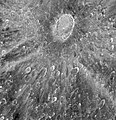File:Moon's impact crater Tycho.jpg

原始文件 (3,930 × 4,075像素,文件大小:5.75 MB,MIME类型:image/jpeg)
摘要
| 描述Moon's impact crater Tycho.jpg |
English: This mottled landscape showing the impact crater Tycho is among the most violent-looking places on our Moon. But astronomers didn’t aim the NASA/ESA Hubble Space Telescope in this direction to study Tycho itself. The image was taken in preparation for the transit of Venus across the Sun’s face on on 5-6 June 2012.
Hubble cannot look at the Sun directly, so astronomers are planning to point the telescope at Earth’s Moon and use it as a mirror to capture reflected sunlight. During the transit a small fraction of that light will have passed through Venus’s atmosphere and imprinted on that light astronomers expect to find the fingerprints of the planet’s atmospheric makeup. These observations will mimic a technique that is already being used to sample the atmospheres of giant planets outside our Solar System passing in front of their stars. In the case of the Venus transit observations, astronomers already know the chemical makeup of Venus’s atmosphere, and that it shows no signs of life. But they can use the event to test whether their technique has a chance of detecting the very faint fingerprints of the atmosphere of an Earth-like planet around another star. This image shows an area approximately 700 kilometres across, and reveals lunar features as small as roughly 170 metres across. The large bullseye near the top of the picture is the impact crater itself, caused by an asteroid strike about 100 million years ago. The bright trail radiating from the crater were formed by material ejected from the impact area during the asteroid collision. Tycho is about 80 kilometers wide and is circled by a rim of material rising almost 5 kilometers above the crater floor. Because the astronomers only have one shot at observing the transit, they had to carefully plan how the study would be carried out. Part of their planning included these test observations of the Moon made on 11 January 2012. This is the last time this century sky watchers can view Venus passing in front of the Sun, as the next transit will not happen until 2117. The image was produced by Hubble’s Advanced Camera for Surveys. A narrow strip along the centre, and small parts of the upper left part of the image were not imaged by Hubble during its observations, and show data from lower-resolution observations made by a ground-based telescope. |
| 日期 | |
| 来源 | http://www.spacetelescope.org/images/potw1219a/ |
| 作者 | NASA, ESA, D. Ehrenreich (Institut de Planétologie et d’Astrophysique de Grenoble (IPAG)/CNRS/Université Joseph Fourier) |
许可协议
- 您可以自由地:
- 共享 – 复制、发行并传播本作品
- 修改 – 改编作品
- 惟须遵守下列条件:
- 署名 – 您必须对作品进行署名,提供授权条款的链接,并说明是否对原始内容进行了更改。您可以用任何合理的方式来署名,但不得以任何方式表明许可人认可您或您的使用。
说明
此文件中描述的项目
描繪內容
7 5 2012
image/jpeg
文件历史
点击某个日期/时间查看对应时刻的文件。
| 日期/时间 | 缩略图 | 大小 | 用户 | 备注 | |
|---|---|---|---|---|---|
| 当前 | 2019年10月19日 (六) 09:16 |  | 3,930 × 4,075(5.75 MB) | BevinKacon | actual size from source |
| 2012年5月8日 (二) 12:39 |  | 1,280 × 1,327(455 KB) | Jmencisom |
文件用途
以下页面使用本文件:
全域文件用途
以下其他wiki使用此文件:
- en.wikipedia.org上的用途
- ja.wikipedia.org上的用途
- mk.wikipedia.org上的用途
- no.wikipedia.org上的用途
元数据
此文件中包含有扩展的信息。这些信息可能是由数码相机或扫描仪在创建或数字化过程中所添加。
如果此文件的源文件已经被修改,一些信息在修改后的文件中将不能完全反映出来。
| 提供人 | NASA, ESA, D. Ehrenreich (Institut de Planétologie et d’Astrophysique de Grenoble (IPAG)/CNRS/Université Joseph Fourier) |
|---|---|
| 来源 | ESA/Hubble |
| 简称 |
|
| 图像标题 |
|
| 使用条款 |
|
| 数据生成日期时间 | 2012年5月7日 (一) 10:00 |
| 关键词 | Moon |
| 联系信息 |
-{R|http://www.spacetelescope.org/}- Karl-Schwarzschild-Strasse 2 Garching bei München, , D-85748 Germany |
| IIM 版本 | 4 |
